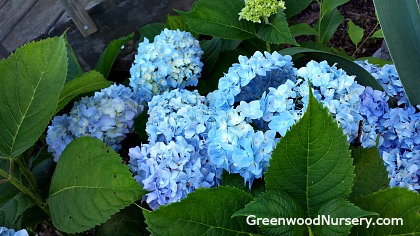Free gardening gloves when you spend $75.00 or more!
Hydrangeas grow and bloom the best in morning sun with afternoon shade. Don't expect them to do well in heavy shade. The Pee Gee variety is hardy enough to grow in full sun.
They prefer plenty of moisture and should be monitored for additional watering over the first and second year after planting and especially during droughts.
Hydrangeas enjoy a regular fertilizing schedule. A good slow (timed) release applied 1-2 times a year will keep them happy. In zones 6-8, fertilize in May and July. For zones 5 and further north, one good fertilizing in June will work due to the shorter growing season. Follow the directions on the fertilizer label. Don't apply fertilize if the plant is wilted or looks otherwise not happy. Take care of the problem and then apply fertilize.
The different varieties of hydrangeas require specific pruning times or blooms for the following year may be lost. Regardless of the variety always remove any dead or broken stems/branches. As the plants age and become mature, prune out about 1/3 of the stems/branches back to ground level. This will keep the shrubs looking healthy.
Pruning hydrangeas
Oakleaf Varieties: Plant 3-4 feet apart. Prune back to about 18-24 inches tall. This plant blooms on new wood and can be pruned back during fall/winter or anytime except during spring when it is preparing to bloom. In the north, it may die back to the ground each year producing new growth each spring.
Limelight, Pee Gee and other Paniculatas: Blooms during mid/late summer and can be pruned during fall/winter or early spring. (Blooms on new wood) As the plant ages, Paniculata blooms often turn a pinkish shade.
Forever Pink, Nikko Blue and other macrophyllas: Prune these varieties in summer (after blooming), but before August. By August, they may have already set their buds for blooming the following year much like azaleas and rhododendrons. They bloom on the old wood, which means the new growth produced after they have completed their blooming in late spring/early summer.
Climbing Hydrangea: Plant growth will be improved by adding organic matter such as aged manure/compost to the soil. Not a fast grower and takes several years to establish after planting. Because it is a vine type plant, other than pruning out any dead branches that are reachable, not much is required to keep it looking good.
Changing the bloom color:
A lot of people send in questions on how to change the bloom color of their hydrangea plants. A white blooming hydrangea will not change to pink or blue no matter what is done to the soil. Although as the white bloomer ages, often the blooms will take on a pinkish shade.
In warmer climates, a red hydrangea doesn't usually produce a true red color.
For Pink blooms: A pH of 6.0 to 6.2 is needed. Add dolomite lime several times a year. Recommended: High Phosphorus fertilizer (ratio close to 25/10/10). This will help to limit the amount of aluminum being absorbed by the plant.
For Blue blooms: A pH of 5.2 to 5.5 is need here. I have read that a solution of ½ oz (1 Tbsp) aluminum sulfate per gallon of water applied to plants which are at least 2-3 years old throughout the growing season will produce blue blooms. Water well before applying the solution and do be cautious in applying as too much can burn the roots. Use a low Phosphorus fertilizer such as a ratio of 25/5/30. Bone should be avoided when attempting to change the color to blue. A natural way to encourage the color change to blue is to apply organic matter to the soil such as coffee grounds, fruit/vegetable peels, grass clippings and other items you would normally add to compost.
The pH of the water should not be any higher than 5.6. Also, planting the hydrangeas next to a concrete foundation or walkway will affect the color and raise the pH with lime seeping out into the soil.
To learn more about hydrangea varieties and growing hydrangeas, click here: Hydrangeas
Cheryl D. Jones, co-owner of Greenwood Nursery, McMinnville, TN, shares tips and information on gardening and landscaping through her blog, newsletters and nursery website. Join the Greenwood Gardeners Club free to receive the nursery's weekly newsletter, access to the members sales page, seasonal promotions and 10% off your first order. Visit Greenwood Nursery for a full line of trees, shrubs, perennials, ground covers and hydrangeas.









